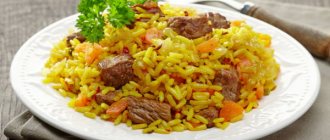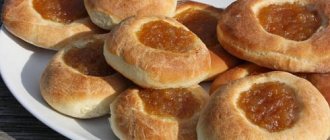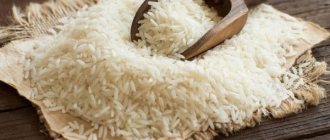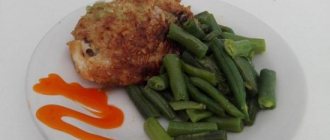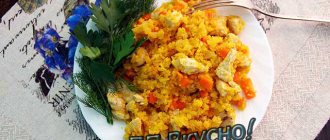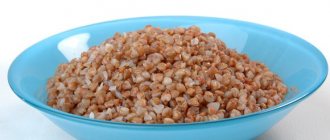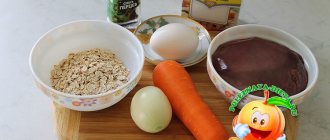Dietary features of pilaf with chicken
This dish consists of products necessary for a healthy human diet. To prepare it, use rice, chicken, onions, carrots, oil, salt, spices, and water.
The main component is rice, which is very beneficial for the human body. It is a source of carbohydrates, proteins and minerals such as iodine, calcium, phosphorus, magnesium, potassium, and it also contains starch, fiber, and B vitamins. Rice has a high content of vitamin B2 (riboflavin), which is involved in the metabolism of amino acids in body.
Rice contains very little fat and is gluten-free, hence can be eaten by people suffering from wheat intolerance. People with diabetes can eat brown rice pilaf.
The next important component, chicken, will further increase the amount of protein in the dish. Chicken contains 15–17% of proteins that are necessary for the human body, a huge number of mineral components, as well as vitamins PP and B. The fat contained in meat is a source of energy that is extremely necessary for vital processes. Therefore, all the useful components collected in the recipe make this chicken dish very nutritious and healthy.
The third important ingredient is vegetables; they contain the fewest calories, therefore, the more of them in this dish, the better. Carrots and onions are fried in a large amount of oil in the classic recipe, but this is a non-dietary case. It is best to avoid frying or fry in a small amount of oil. To reduce calorie content, it would be better to cook chopped vegetables along with pieces of chicken in a slow cooker. If you really want, you can add a little olive oil there.
Description
From early childhood, the diet includes porridge made from rice. Dishes made from this cereal are tasty and healthy. It can be boiled in milk or water, with pumpkin, vegetables, fruits or berries, nuts and dried fruits. These additives diversify the taste and at the same time affect the calorie content of the product only slightly. Milk porridge with sugar and butter for breakfast is no less tasty; In addition, such a product will saturate the body for a long time.
Due to its high starch content, short grain rice is ideal for preparing milk porridges with a uniform consistency. Dishes made from brown rice are especially healthy: the grain shell, rich in nutrients, is completely preserved.
Dishes prepared on the basis of rice differ from other similar ones in the absence of gluten, which often becomes an allergen. Rice has no salt and few calories, which makes dishes made from it dietary. In addition, the product is rich in microelements: zinc, calcium, phosphorus, iron, magnesium, potassium, iodine and selenium.
How many calories are in pilaf with chicken?
The calorie content of this dish depends on the method of preparation, types of cereals, additional components and ranges from 110 to 130 kilocalories. Rice is quite high in calories; 100 grams of cereal contains 360 kcal. When cooked, rice absorbs water and when cooked, 100 grams contain 150 kcal.
There are two methods of preparation:
- Iranian (meat and rice are cooked separately, and when served they are placed on one plate without mixing).
- Central Asian (they start cooking the meat, and then add raw rice when it is half cooked).
A dish prepared according to the Iranian method is lower in calories, especially if the rice is steamed or without fat. The calorie content and taste of this dish depend on the type of cereal. The best choice is the classic round white one, but gourmets say that the long-grain red one is best, since it contains more microelements and is healthier. Sometimes rice is replaced with other cereals - peas, wheat, chickpeas.
Nutritionists advise people who want to lose weight to eat seasonings, because they improve intestinal function and speed up metabolism, which promotes weight loss.
Most often, the following spices are added to prepare a dietary dish:
- saffron to give the rice a golden color;
- garlic;
- curry;
- khmeli-suneli;
- barberry;
- red, black pepper - increase the metabolic rate, so calories do not end up in unnecessary places.
Useful tips and tricks
Preparing porridge is quite simple, but there are many factors that can adversely affect the result.
Here are some tips to help speed up the process:
- You should choose the lightest varieties of rice - they cook better.
- Steamed rice is suitable for crumbly dishes, but not for porridges; it is better not to buy it.
- For rinsing and soaking, a fine-mesh strainer is suitable, and the water should be released in a thin stream.
- It is more convenient to combine washing and soaking with the preparation of water or milk;
- Porridges made with milk are made thinner than those made with water.
- The most suitable pan is tall and has a non-stick coating. The height of the pan will prevent the porridge from escaping.
- A flat wooden spatula is best for stirring. A lump of porridge will collect in the recess of the spoon and will not be able to cook.
- Milk itself has a sweet taste, so it is very difficult to get unsweetened porridge with milk. On the other hand, the amount of sugar it requires is a little less.
Popular additives to the finished dish and their effect on calorie content:
| Ingredient names | Effect on energy value (calorie content) |
| Butter | High |
| Pumpkin | Average |
| Apples | Low |
| Walnuts | High |
| Dried fruits | Average |
| Jam | Average |
| Honey | Average |
| Meat | High |
Each housewife has her own arsenal of tricks that speed up and simplify the preparation of rice porridge with milk or water. The calorie content of the finished product can be easily adjusted to suit the needs of the family.
It is no longer possible to reduce the energy value of the finished product, so those who want to lose weight or count calories for another reason should immediately prepare a dish with the required calorie content.
Chicken pilaf recipes
Chicken pilaf cooked in a slow cooker
Ingredients:
- 0.5 kilograms of chicken meat;
- 200 grams of rice;
- 4 glasses of water;
- 200 grams of onions;
- 200 grams of carrots;
- 6 cloves of garlic;
- Oil, salt, spices - to taste.
Preparation:
Turn on the multicooker in the “Baking” mode for half an hour and heat the oil in it. Grind the chicken meat and fry for 15–20 minutes in vegetable oil, without covering the multicooker, until golden brown. Add chopped onion and grated carrots. Fry the meat and vegetables and do not forget to stir until the end of the cycle.
Prepare the rice, rinse it and add water. After the signal indicating the end of frying, drain the water from the rice and pour it into the multicooker container. Place garlic cloves (unpeeled) into the rice, add spices and salt. Fill with hot water and close the lid. Set the “Pilaf” mode. After finishing cooking, turn on the “Warming” mode for 15 minutes, without opening the lid, so that the rice reaches the ready state. Then mix all the layers and you can serve.
Low-calorie chicken pilaf
It can be cooked either in a slow cooker or on the stove. For 100 grams of food there are only 68 kcal.
Ingredients:
- 500 grams of chicken breast;
- 150 grams of brown rice;
- 125 grams of champignons;
- 2 leeks;
- 220 grams of frozen vegetable mixture;
- 4 pieces of tomatoes;
- 1 cup chicken or vegetable broth;
- 15 grams of red pepper;
- 2 tablespoons of chopped herbs;
- Salt - to taste.
Preparation:
Cook like regular pilaf, only add vegetables and mushrooms after the meat has boiled for a few minutes. When serving, sprinkle with herbs. The dish turns out to be unique, but very healthy and low in calories.
Different countries have their own variations and names of this dish.
, in Spain it is called paella, in Italy it is called risotto. In Thailand, they use a huge amount of spices when cooking; in Japan, they cook it with chicken and soy sauce. Uzbeks cook real pilaf only among the stronger sex. There is such a version that pilaf used to be a vegetarian dish and it appeared in India, but the Uzbeks and other peoples disagree with this. The inhabitants of Asia have such a proverb - “The poor man eats pilaf, the rich man eats only pilaf,” and that’s true, pilaf – a favorite dish of Asians.
Pilaf is a tasty, satisfying and beloved dish by many, containing everything you need for good nutrition. Pilaf contains meat, onions, rice, carrots, fat, salt, and water.
The main ingredient in pilaf is rice. It is rich in vitamin B2 and has a positive effect on the metabolism of amino acids in the body.
According to nutritionists, the beneficial properties of pilaf are absorbed by ninety-eight percent, which is a high figure.
The calorie content of pilaf is high, but this dish is easily digested by the human body. Depending on the ingredients, the calorie content of pilaf may vary. It's no secret that the basis of almost any type of pilaf is meat. To give pilaf a special aroma and exquisite taste, meat with bones must be added to it. It could be chicken or pork, beef or lamb. All these products are nutritious and give high calorie content to pilaf.
How many calories are in pilaf? In fact, the calorie content of pilaf depends on whether the pilaf is meat or not.
For example, the calorie content of meat pilaf is 287 kcal per hundred grams of product, and the calorie content of vegetable pilaf is only 100 kcal per hundred grams of product. Therefore, it is impossible to accurately answer the question - how many calories are in pilaf. It all depends on the ingredients included in its composition.
It should also be noted that pilaf contains two important ingredients - onions and carrots. Onions contain phytoncides and vitamin C, which protect the body from colds. Carrots are known for containing vitamins PP, A and C and B vitamins.
The calorie content of pilaf also includes salt. Despite the fashion of various salt-free diets, experts have proven that salt is necessary for normal blood composition. Another thing is to adhere to the norm and not break it. So, for a healthy person, the daily salt intake is 10 or 15 mg, depending on weight and height.
The salt present in pilaf is completely absorbed by the human body, approximately 98 percent.
In addition to the fact that pilaf is delicious, it is considered a healthy dish for those who suffer from anemia, tuberculosis, anemia and experience loss of strength and fatigue.
To prepare pilaf according to the classic recipe, you will need a cast-iron cauldron with thick walls and it must be cooked over a fire. But today this method is a thing of the past and people treat the process of preparing pilaf much more simply.
Benefits and harms
Next, let’s find out what benefits or harms the most popular white rice in our country has for the body. It contains very important trace elements and vitamins, as described in the table, the benefits of which are also well studied.
Contents and benefits of microelements and vitamins per 100 grams of dry rice
| Name | Content | Daily requirement % |
| Co (cobalt) | 1 mg | 100 |
| H (biotin) | 3.5 mcg | 0.35 |
| PP (niacin) | 1.6 mg | 6.4 |
| K (potassium) | 100 mg | 5 |
| Ca (calcium) | 8 mg | 0.8 |
| E (tocopherol) | 0.45 mg | 4.5 |
| Mg (magnesium) | 48 mg | 14 |
| B9 (folic acid) | 19 mcg | 2 |
| B1 (thiamine) | 0.08 mg | 5.3 |
| B5 (panthenol) | 0.4 mg | 6 |
| B6 (pyridoxine) | 0.18 mg | 9 |
| Fe (iron) | 1.02 mg | 7 |
| Cu (copper) | 0.25 mg | 17 |
| B2 (riboflavin) | 0.04 mg | 2.5 |
| Zn (Zinc) | 0.45 mg | 4.5 |
Rice contains manganese and chromium, which are responsible for the normal functioning of the central nervous and reproductive systems, hematopoiesis and energy processes, the synthesis of carbohydrates and proteins. The benefits of rice are irreplaceable for problems with the gastrointestinal tract; it helps with diarrhea, eliminates constipation, thanks to fiber, and improves intestinal motility.
For the cardiovascular system, the benefits of rice are in cleansing the blood and removing toxins, cholesterol, strengthening the heart muscle and blood vessels.
There are noticeable benefits of regular consumption of rice for hair, skin and nails, teeth, strengthening muscles and bones. Helps fight salt deposits, which improves the condition of joints. Also, the rice diet significantly improves appetite.

If we talk about harm, then rice can cause constipation and even provoke hemorrhoids, especially for the white variety. In case of diabetes, there may be harm from the high content of easily digestible carbohydrates in rice. Often, harm occurs against the background of acute stomach diseases, so you need to be careful and consult your doctor. You should eat rice correctly with other foods, because if combined incorrectly, rice can harm your figure due to the excessive calorie content of the dishes.
Rice and seasonings for pilaf
As you know, pilaf is high in calories due to the meat it contains. But pilaf also contains rice and spices, which are also high in calories. Pilaf is popular among many peoples, especially in Central Asia, where it has been revered for many centuries.
Many people are interested not only in the question - how many calories are in pilaf, but also in the question - which rice is best suited for preparing it?
The modern food industry today offers several varieties of rice. It comes in long grain, round, sanded and unpolished, as well as brown and white.
To find out which rice is best suited for pilaf, you should pay attention to the different characteristics of the grain.
For example, round rice is overcooked, it is sticky and often sticks together. This rice is good for soups and liquid porridges.
Long grain rice is a bit dry, but when cooked, the rice grains do not lose their shape, and the dish turns out crumbly. It is great for preparing pilaf and as a side dish for salads and meat dishes.
Today there are many ways to prepare pilaf, each nationality brings its own ingredients and characteristics to it. Adding new components leads to the creation of new pilaf flavors. And today it is impossible to say with confidence which of the recipes is the most correct, and which rice is best suited for pilaf.
As for the seasonings that add calories to pilaf, you can buy them ready-made in a store or market - there the spices are specially selected to create a balanced mixture based on oriental recipes. For example, the seasoning for pilaf includes dried barberry, turmeric, cumin and red pepper.
In addition, the seasoning for pilaf may contain saffron, savory, coriander, sweet paprika, and chili pepper. Also, in the process of making pilaf, aromatic herbs, cilantro and parsley can be added to it.
Each ingredient in the pilaf seasoning is responsible for certain properties and qualities that are transferred to the finished dish. For example, saffron or turmeric not only gives pilaf more calories, but also a yellow-orange color. Barberry gives the pilaf a sour taste, and cumin gives it an oriental aroma.
Using ready-made seasoning for pilaf is a personal matter for each cook. The most important thing is that the end result is excellent pilaf in the oriental style, the mere sight of which will whet your appetite and lift your spirits.
Product calorie analysis
Ratio of proteins, fats and carbohydrates:
- Vitamin A is responsible for normal development, reproductive function, skin and eye health, and maintaining immunity.
- B-carotene is provitamin A and has antioxidant properties. 6 mcg of beta carotene is equivalent to 1 mcg of vitamin A.
- Vitamin B6 is involved in maintaining the immune response, processes of inhibition and excitation in the central nervous system, in the transformation of amino acids, the metabolism of tryptophan, lipids and nucleic acids, promotes the normal formation of red blood cells, and maintaining normal levels of homocysteine in the blood. Insufficient intake of vitamin B6 is accompanied by decreased appetite, impaired skin condition, and the development of homocysteinemia and anemia.
- Vitamin E has antioxidant properties, is necessary for the functioning of the gonads and heart muscle, and is a universal stabilizer of cell membranes. With vitamin E deficiency, hemolysis of erythrocytes and neurological disorders are observed.
- Vitamin PP is involved in redox reactions of energy metabolism. Insufficient vitamin intake is accompanied by disruption of the normal condition of the skin, gastrointestinal tract and nervous system.
- Silicon is included as a structural component in glycosaminoglycans and stimulates collagen synthesis.
- Magnesium is involved in energy metabolism, the synthesis of proteins, nucleic acids, has a stabilizing effect on membranes, and is necessary to maintain the homeostasis of calcium, potassium and sodium. A lack of magnesium leads to hypomagnesemia, an increased risk of developing hypertension and heart disease.
- Phosphorus takes part in many physiological processes, including energy metabolism, regulates acid-base balance, is part of phospholipids, nucleotides and nucleic acids, and is necessary for the mineralization of bones and teeth. Deficiency leads to anorexia, anemia, and rickets.
- Cobalt is part of vitamin B12. Activates enzymes of fatty acid metabolism and folic acid metabolism.
- Manganese is involved in the formation of bone and connective tissue, and is part of enzymes involved in the metabolism of amino acids, carbohydrates, and catecholamines; necessary for the synthesis of cholesterol and nucleotides. Insufficient consumption is accompanied by slower growth, disturbances in the reproductive system, increased fragility of bone tissue, and disturbances in carbohydrate and lipid metabolism.
- Copper is part of enzymes that have redox activity and are involved in the metabolism of iron, stimulates the absorption of proteins and carbohydrates. Participates in the processes of providing oxygen to the tissues of the human body. Deficiency is manifested by disturbances in the formation of the cardiovascular system and skeleton, and the development of connective tissue dysplasia.
- Molybdenum is a cofactor for many enzymes that ensure the metabolism of sulfur-containing amino acids, purines and pyrimidines.
- Selenium is an essential element of the antioxidant defense system of the human body, has an immunomodulatory effect, and is involved in the regulation of the action of thyroid hormones. Deficiency leads to Kashin-Beck disease (osteoarthritis with multiple deformities of the joints, spine and limbs), Keshan disease (endemic myocardiopathy), and hereditary thrombasthenia.
more hide
Hearty rice porridge with milk has a high calorie content and is suitable as a complete independent dish, and its analogue with water is ideal for weight loss. The high fiber and carbohydrate content gives a long-lasting feeling of fullness and stable, without spikes in blood glucose levels.
Calorie content of pilaf with chicken
The calorie content of chicken pilaf is of great interest to many people. Of all types of meat, chicken is the one that stands out for its dietary properties. This is relevant for those who want to lose excess weight or simply want to control the number of calories in food, but do not want to give up their favorite dish. Let's figure out what the calorie content of pilaf with chicken is.
The calorie content of pilaf with chicken is 190 kcal per hundred grams of product, which is a fairly high indicator, since approximately 300 grams of pilaf fits on a standard plate - one serving.
The calorie content of pilaf with chicken may vary depending on the ingredients added to it.
Chicken, which is part of the pilaf, increases the protein content in the dish and makes it filling. Chicken meat contains 16 percent of the proteins that the human body needs, as well as vitamins B, A and PP.
The calorie content of pilaf with pork cannot be called low. But, despite the high calorie content of pilaf, few people refuse it.
The main component of pilaf with pork is rice. Rice, as you know, is a healthy product, representing a rich source of proteins, mineral components, carbohydrates - calcium, potassium, magnesium, phosphorus. The fat content in rice is low. It does not contain glucene, due to which it can be consumed by people who suffer from wheat intolerance, and for those who suffer from diabetes mellitus, pilaf made from brown rice will be useful.4.8571428571429
4.86 out of 5 (7 Votes)
Pilaf is one of the most popular oriental dishes, which our compatriots also love. By the way, it is also extremely useful. The only thing that stops you from consuming it often is how many calories are in pilaf
. Many people rightly believe that this culinary masterpiece is quite high in calories.
With pork
This food is the leader in fat content, and therefore is absorbed by the body worse than all others. People suffering from diseases of the gastrointestinal tract and watching their waistline should not use it.
The calorie content of pilaf with pork is on average 290 calories per 100 grams. It is of great importance which part of the carcass you use: white meat has lower energy value, but red and fatty pieces are higher in calories.
If you add a component such as lard, the nutritional value of the product increases to 300-340 calories.
How many calories are in pilaf 100 grams
It should be noted that pilaf is absorbed by the human body by 99 percent, according to nutritionists. Although it has a fairly high calorie content, it is completely processed, which means that in any case it will not affect the figure with moderate consumption. In addition, the main components contain a lot of various useful substances and vitamins. The indicator is how many calories are in one hundred grams of pilaf
, depends on what ingredients you use. In the classic recipe, in particular, there are:
- carrot;
- spices (barberry, cumin, turmeric, etc.);
- salt;
- meat;
- garlic;
- water.
The main component that affects the calorie content of pilaf is meat. The original recipe, which is passed down from generation to generation, contains lamb. About 236 kcal – that’s how many calories are in lamb pilaf
. It's not that much. Please also note that pilaf is a nutritious dish; after eating a 300-gram portion, you will not feel hungry for a long time.
